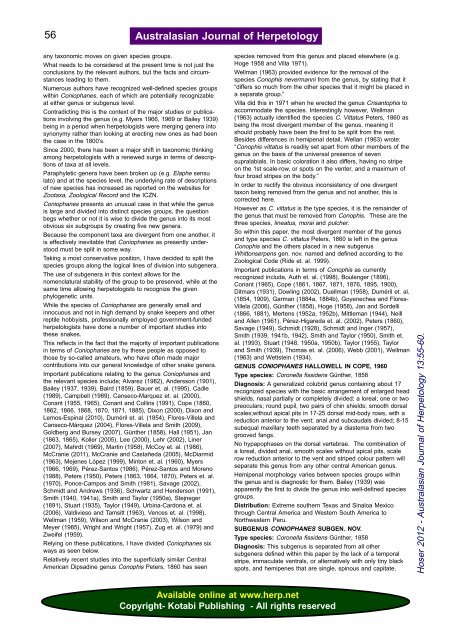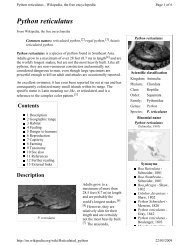Issue Thirteen 30 June 2012 - Taxonomic issue - all - Smuggled.com
Issue Thirteen 30 June 2012 - Taxonomic issue - all - Smuggled.com
Issue Thirteen 30 June 2012 - Taxonomic issue - all - Smuggled.com
You also want an ePaper? Increase the reach of your titles
YUMPU automatically turns print PDFs into web optimized ePapers that Google loves.
56<br />
any taxonomic moves on given species groups.<br />
What needs to be considered at the present time is not just the<br />
conclusions by the relevant authors, but the facts and circumstances<br />
leading to them.<br />
Numerous authors have recognized well-defined species groups<br />
within Coniophanes, each of which are potenti<strong>all</strong>y recognizable<br />
at either genus or subgenus level.<br />
Contradicting this is the context of the major studies or publications<br />
involving the genus (e.g. Myers 1966, 1969 or Bailey 1939)<br />
being in a period when herpetologists were merging genera into<br />
synonymy rather than looking at erecting new ones as had been<br />
the case in the 1800’s.<br />
Since 2000, there has been a major shift in taxonomic thinking<br />
among herpetologists with a renewed surge in terms of descriptions<br />
of taxa at <strong>all</strong> levels.<br />
Paraphyletic genera have been broken up (e.g. Elaphe sensu<br />
lato) and at the species level, the underlying rate of descriptions<br />
of new species has increased as reported on the websites for<br />
Zootaxa, Zoological Record and the ICZN.<br />
Coniophanes presents an unusual case in that while the genus<br />
is large and divided into distinct species groups, the question<br />
begs whether or not it is wise to divide the genus into its most<br />
obvious six subgroups by creating five new genera.<br />
Because the <strong>com</strong>ponent taxa are divergent from one another, it<br />
is effectively inevitable that Coniophanes as presently understood<br />
must be split in some way.<br />
Taking a most conservative position, I have decided to split the<br />
species groups along the logical lines of division into subgenera.<br />
The use of subgenera in this context <strong>all</strong>ows for the<br />
nomenclatural stability of the group to be preserved, while at the<br />
same time <strong>all</strong>owing herpetologists to recognize the given<br />
phylogenetic units.<br />
While the species of Coniophanes are gener<strong>all</strong>y sm<strong>all</strong> and<br />
innocuous and not in high demand by snake keepers and other<br />
reptile hobbyists, profession<strong>all</strong>y employed government-funded<br />
herpetologists have done a number of important studies into<br />
these snakes.<br />
This reflects in the fact that the majority of important publications<br />
in terms of Coniophanes are by these people as opposed to<br />
those by so-c<strong>all</strong>ed amateurs, who have often made major<br />
contributions into our general knowledge of other snake genera.<br />
Important publications relating to the genus Coniophanes and<br />
the relevant species include; Alvarez (1982), Andersson (1901),<br />
Bailey (1937, 1939), Baird (1859), Bauer et. al. (1995), Cadle<br />
(1989), Campbell (1989), Canseco-Marquez et. al. (2000),<br />
Conant (1955, 1965), Conant and Collins (1991), Cope (1860,<br />
1862, 1866, 1868, 1870, 1871, 1885), Dixon (2000), Dixon and<br />
Lemos-Espinal (2010), Duméril et. al. (1854), Flores-Villela and<br />
Canseco-Márquez (2004), Flores-Villela and Smith (2009),<br />
Goldberg and Bursey (2007), Günther (1858), H<strong>all</strong> (1951), Jan<br />
(1863, 1865), Koller (2005), Lee (2000), Lehr (2002), Liner<br />
(2007), Mahrdt (1969), Martin (1958), McCoy et. al. (1986),<br />
McCranie (2011), McCranie and Castañeda (2005), McDiarmid<br />
(1963), Mejenes López (1999), Minton et. al. (1960), Myers<br />
(1966, 1969), Pérez-Santos (1986), Pérez-Santos and Moreno<br />
(1988), Peters (1950), Peters (1863, 1864, 1870), Peters et. al.<br />
(1970), Ponce-Campos and Smith (1981), Savage (2002),<br />
Schmidt and Andrews (1936), Schwartz and Henderson (1991),<br />
Smith (1940, 1941a), Smith and Taylor (1950a), Stejneger<br />
(1891), Stuart (1935), Taylor (1949), Urbina-Cardona et. al.<br />
(2006), Valdivieso and Tamsitt (1963), Vences et. al. (1998),<br />
Wellman (1959), Wilson and McCranie (2003), Wilson and<br />
Meyer (1985), Wright and Wright (1957), Zug et. al. (1979) and<br />
Zweifel (1959).<br />
Relying on these publications, I have divided Coniophanes six<br />
ways as seen below.<br />
Relatively recent studies into the superfici<strong>all</strong>y similar Central<br />
American Dipsadine genus Conophis Peters, 1860 has seen<br />
Australasian Journal of Herpetology<br />
species removed from this genus and placed elsewhere (e.g.<br />
Hoge 1958 and Villa 1971).<br />
Wellman (1963) provided evidence for the removal of the<br />
species Conophis nevermanni from the genus, by stating that it<br />
“differs so much from the other species that it might be placed in<br />
a separate group.”<br />
Villa did this in 1971 when he erected the genus Crisantophis to<br />
ac<strong>com</strong>modate the species. Interestingly however, Wellman<br />
(1963) actu<strong>all</strong>y identified the species C. Vittatus Peters, 1860 as<br />
being the most divergent member of the genus, meaning it<br />
should probably have been the first to be split from the rest.<br />
Besides differences in hemipenal detail, Wellan (1963) wrote:<br />
“Conophis vittatus is readily set apart from other members of the<br />
genus on the basis of the universal presence of seven<br />
supralabials. In basic coloration it also differs, having no stripe<br />
on the 1st scale-row, or spots on the venter, and a maximum of<br />
four broad stripes on the body.”<br />
In order to rectify the obvious inconsistency of one divergent<br />
taxon being removed from the genus and not another, this is<br />
corrected here.<br />
However as C. vittatus is the type species, it is the remainder of<br />
the genus that must be removed from Conophis. These are the<br />
three species, lineatus, morai and pulcher.<br />
So within this paper, the most divergent member of the genus<br />
and type species C. vittatus Peters, 1860 is left in the genus<br />
Conophis and the others placed in a new subgenus<br />
Whittonserpens gen. nov. named and defined according to the<br />
Zoological Code (Ride et. al. 1999).<br />
Important publications in terms of Conophis as currently<br />
recognized include, Auth et. al. (1998), Boulenger (1896),<br />
Conant (1965), Cope (1861, 1867, 1871, 1876, 1895, 1900),<br />
Ditmars (1931), Dowling (2002), Duellman (1958), Duméril et. al.<br />
(1854, 1909), Garman (1884a, 1884b), Goyenechea and Flores-<br />
Villela (2006), Günther (1858), Hoge (1958), Jan and Sordelli<br />
(1866, 1881), Mertens (1952a, 1952b), Mittleman (1944), Neill<br />
and Allen (1961), Pérez-Higareda et. al. (2002), Peters (1860),<br />
Savage (1949), Schmidt (1928), Schmidt and Inger (1957),<br />
Smith (1939, 1941b, 1942), Smith and Taylor (1950), Smith et.<br />
al. (1993), Stuart (1948, 1950a, 1950b), Taylor (1955), Taylor<br />
and Smith (1939), Thomas et. al. (2006), Webb (2001), Wellman<br />
(1963) and Wettstein (1934).<br />
GENUS CONIOPHANES HALLOWELL IN COPE, 1960<br />
Type species: Coronella fissidens Günther, 1858<br />
Diagnosis: A generalized colubrid genus containing about 17<br />
recognized species with the basic arrangement of enlarged head<br />
shields, nasal parti<strong>all</strong>y or <strong>com</strong>pletely divided; a loreal; one or two<br />
preoculars; round pupil, two pairs of chin shields; smooth dorsal<br />
scales;without apical pits in 17-25 dorsal mid-body rows, with a<br />
reduction anterior to the vent; anal and subcaudals divided; 8-15<br />
subequal maxillary teeth separated by a diastema from two<br />
grooved fangs.<br />
No hypapophases on the dorsal vertebrae. The <strong>com</strong>bination of<br />
a loreal, divided anal, smooth scales without apical pits, scale<br />
row reduction anterior to the vent and striped colour pattern will<br />
separate this genus from any other central American genus.<br />
Hemipenal morphology varies between species groups within<br />
the genus and is diagnostic for them. Bailey (1939) was<br />
apparently the first to divide the genus into well-defined species<br />
groups.<br />
Distribution: Extreme southern Texas and Sinaloa Mexico<br />
through Central America and Western South America to<br />
Northwestern Peru.<br />
SUBGENUS CONIOPHANES SUBGEN. NOV.<br />
Type species: Coronella fissidens Günther, 1858<br />
Diagnosis: This subgenus is separated from <strong>all</strong> other<br />
subgenera defined within this paper by the lack of a temporal<br />
stripe, immaculate ventrals, or alternatively with only tiny black<br />
spots, and hemipenes that are single, spinous and capitate.<br />
Available online at www.herp.net<br />
Copyright- Kotabi Publishing - All rights reserved<br />
Hoser <strong>2012</strong> - Australasian Journal of Herpetology 13:55-60.



